Operations Management: Lean Principles Implementation at SONAE MC
VerifiedAdded on 2023/06/08
|11
|3653
|175
Case Study
AI Summary
This report provides an analysis of the application of lean principles and related models within a project focused on waste disposal and process optimization. It highlights the core concept of waste reduction and its transformative impact on business operations. The report discusses key functions such as WIP level management, raw material procurement, stock control, and quality assurance. It details the momentum generation for project initiation, the lifecycle of lean project implementation across different divisions, and the challenges encountered, including supply chain issues and employee development. The extension of lean principles to customer flows and techniques for sustaining motivation and continuous improvement are also explored. The reflection emphasizes the integration of lean principles into the organizational structure, discussing both advantages and disadvantages of lean project implementation, with the aim of enhancing operational effectiveness and competitiveness.
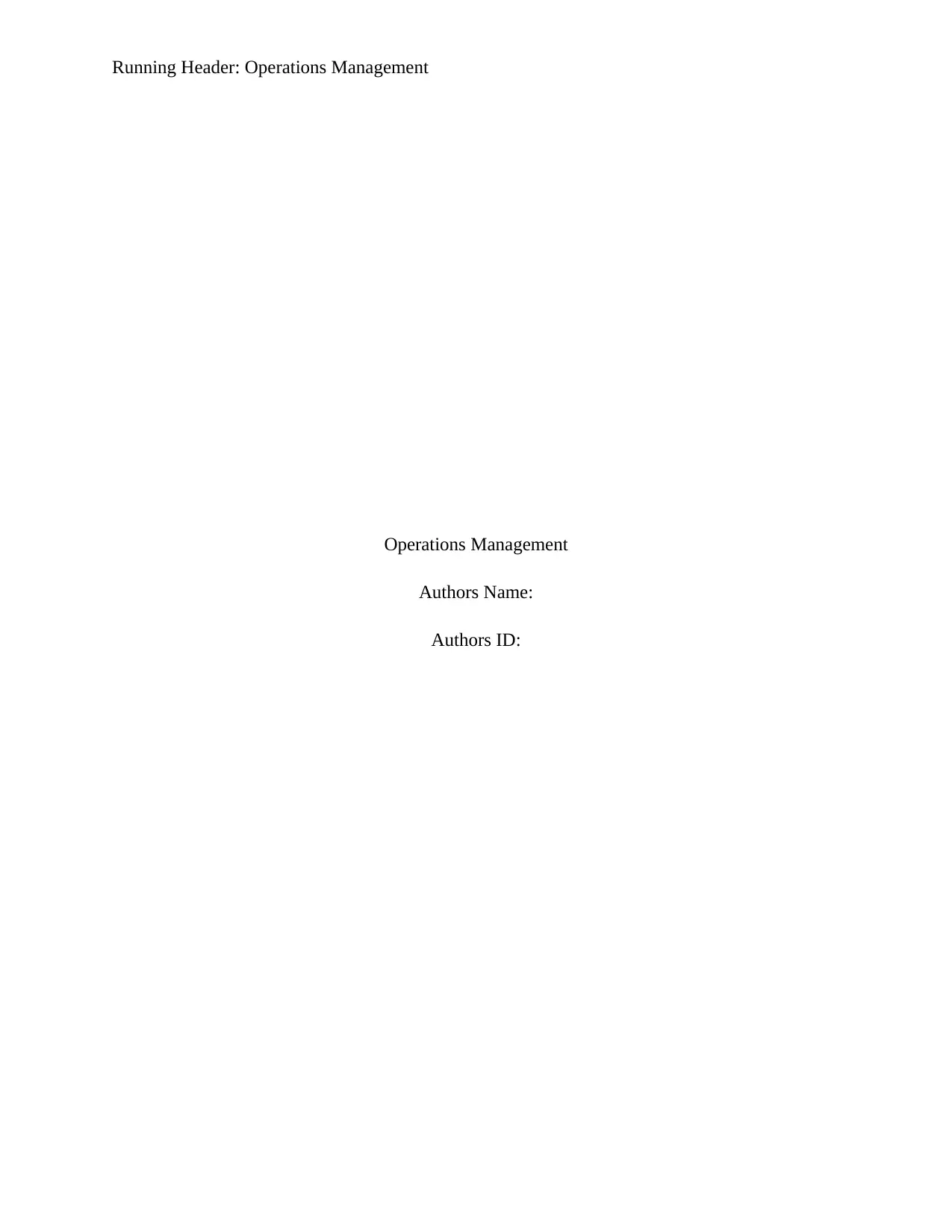
Running Header: Operations Management
Operations Management
Authors Name:
Authors ID:
Operations Management
Authors Name:
Authors ID:
Paraphrase This Document
Need a fresh take? Get an instant paraphrase of this document with our AI Paraphraser
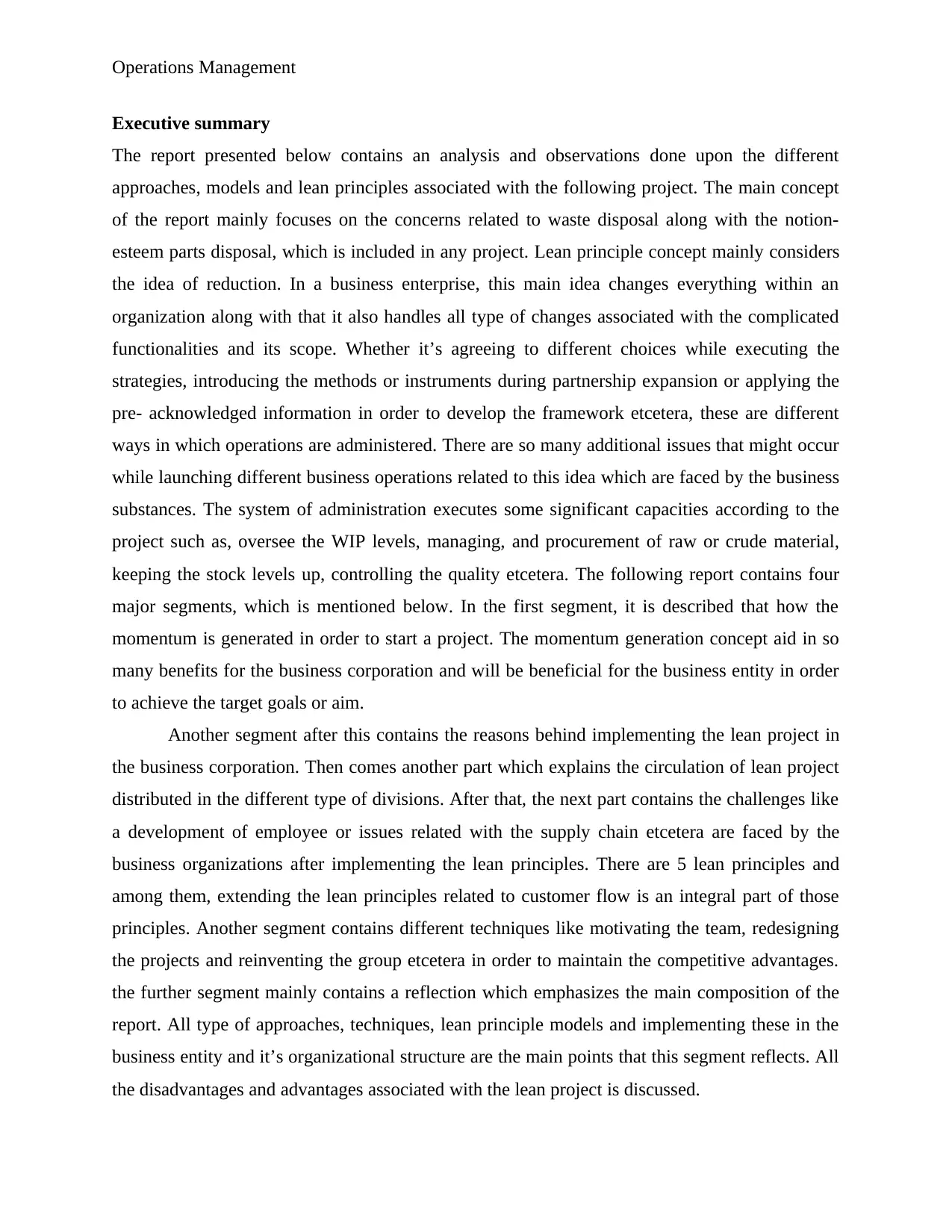
Operations Management
Executive summary
The report presented below contains an analysis and observations done upon the different
approaches, models and lean principles associated with the following project. The main concept
of the report mainly focuses on the concerns related to waste disposal along with the notion-
esteem parts disposal, which is included in any project. Lean principle concept mainly considers
the idea of reduction. In a business enterprise, this main idea changes everything within an
organization along with that it also handles all type of changes associated with the complicated
functionalities and its scope. Whether it’s agreeing to different choices while executing the
strategies, introducing the methods or instruments during partnership expansion or applying the
pre- acknowledged information in order to develop the framework etcetera, these are different
ways in which operations are administered. There are so many additional issues that might occur
while launching different business operations related to this idea which are faced by the business
substances. The system of administration executes some significant capacities according to the
project such as, oversee the WIP levels, managing, and procurement of raw or crude material,
keeping the stock levels up, controlling the quality etcetera. The following report contains four
major segments, which is mentioned below. In the first segment, it is described that how the
momentum is generated in order to start a project. The momentum generation concept aid in so
many benefits for the business corporation and will be beneficial for the business entity in order
to achieve the target goals or aim.
Another segment after this contains the reasons behind implementing the lean project in
the business corporation. Then comes another part which explains the circulation of lean project
distributed in the different type of divisions. After that, the next part contains the challenges like
a development of employee or issues related with the supply chain etcetera are faced by the
business organizations after implementing the lean principles. There are 5 lean principles and
among them, extending the lean principles related to customer flow is an integral part of those
principles. Another segment contains different techniques like motivating the team, redesigning
the projects and reinventing the group etcetera in order to maintain the competitive advantages.
the further segment mainly contains a reflection which emphasizes the main composition of the
report. All type of approaches, techniques, lean principle models and implementing these in the
business entity and it’s organizational structure are the main points that this segment reflects. All
the disadvantages and advantages associated with the lean project is discussed.
Executive summary
The report presented below contains an analysis and observations done upon the different
approaches, models and lean principles associated with the following project. The main concept
of the report mainly focuses on the concerns related to waste disposal along with the notion-
esteem parts disposal, which is included in any project. Lean principle concept mainly considers
the idea of reduction. In a business enterprise, this main idea changes everything within an
organization along with that it also handles all type of changes associated with the complicated
functionalities and its scope. Whether it’s agreeing to different choices while executing the
strategies, introducing the methods or instruments during partnership expansion or applying the
pre- acknowledged information in order to develop the framework etcetera, these are different
ways in which operations are administered. There are so many additional issues that might occur
while launching different business operations related to this idea which are faced by the business
substances. The system of administration executes some significant capacities according to the
project such as, oversee the WIP levels, managing, and procurement of raw or crude material,
keeping the stock levels up, controlling the quality etcetera. The following report contains four
major segments, which is mentioned below. In the first segment, it is described that how the
momentum is generated in order to start a project. The momentum generation concept aid in so
many benefits for the business corporation and will be beneficial for the business entity in order
to achieve the target goals or aim.
Another segment after this contains the reasons behind implementing the lean project in
the business corporation. Then comes another part which explains the circulation of lean project
distributed in the different type of divisions. After that, the next part contains the challenges like
a development of employee or issues related with the supply chain etcetera are faced by the
business organizations after implementing the lean principles. There are 5 lean principles and
among them, extending the lean principles related to customer flow is an integral part of those
principles. Another segment contains different techniques like motivating the team, redesigning
the projects and reinventing the group etcetera in order to maintain the competitive advantages.
the further segment mainly contains a reflection which emphasizes the main composition of the
report. All type of approaches, techniques, lean principle models and implementing these in the
business entity and it’s organizational structure are the main points that this segment reflects. All
the disadvantages and advantages associated with the lean project is discussed.
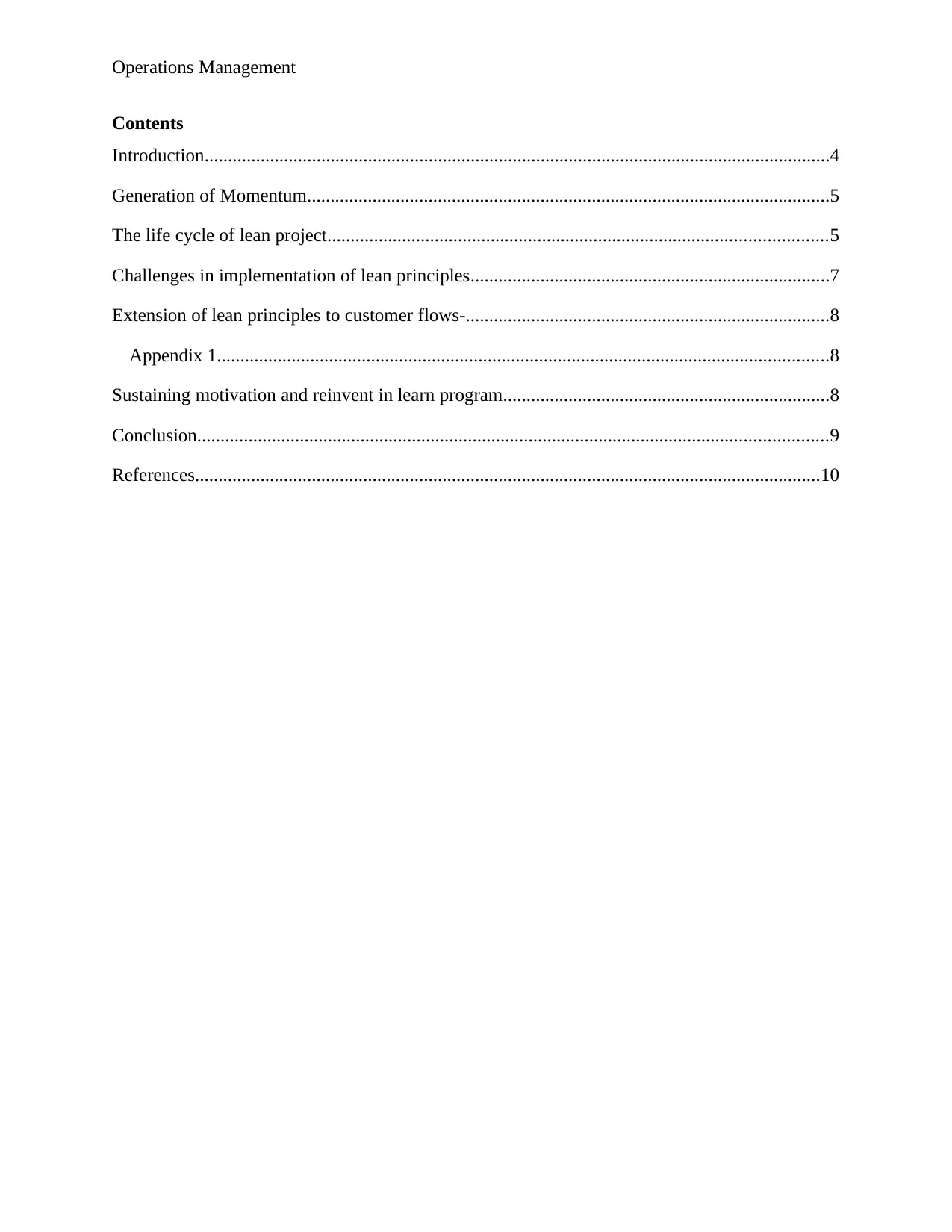
Operations Management
Contents
Introduction......................................................................................................................................4
Generation of Momentum................................................................................................................5
The life cycle of lean project...........................................................................................................5
Challenges in implementation of lean principles.............................................................................7
Extension of lean principles to customer flows-..............................................................................8
Appendix 1...................................................................................................................................8
Sustaining motivation and reinvent in learn program......................................................................8
Conclusion.......................................................................................................................................9
References......................................................................................................................................10
Contents
Introduction......................................................................................................................................4
Generation of Momentum................................................................................................................5
The life cycle of lean project...........................................................................................................5
Challenges in implementation of lean principles.............................................................................7
Extension of lean principles to customer flows-..............................................................................8
Appendix 1...................................................................................................................................8
Sustaining motivation and reinvent in learn program......................................................................8
Conclusion.......................................................................................................................................9
References......................................................................................................................................10
⊘ This is a preview!⊘
Do you want full access?
Subscribe today to unlock all pages.

Trusted by 1+ million students worldwide

Operations Management
Introduction
Operation administrations can be defined as all the tools and methodologies required in the
operations and projects of the business organizations in order to obtain maximum productivity or
profit in the business corporation. The administrations or the business organizations which are
related to these projects or the operations have been mainly influenced by a major thought which
can be handled or managed by the business entities in order for them to create and raise the level
of their capability (Brown, Bessant and Lamming, 2013). This key thought will help to
improvise the operations and functionalities carried on by the business administration and also to
increase the level of effectiveness in the operations. To gain more and more profit and a higher
level of efficiency along with more gainfulness, it is very important to transform the available
information and the raw materials in a very improvised way. Items or ventures obtained by the
raw material should be more effective and improvised. While deciding the production costs it
becomes very important to also consider the income. Maintaining a harmony between production
cost and the obtained money is very important because it allows the business enterprise to obtain
the maximum net benefit (Goetsch and Davis, 2014). Administration system works in the interest
of the business organization or a business entity to use the human assets, devices, technology,
devices, surplus, and imagination etcetera in an ideal and efficient way.
Along with all these, the administration also oversees the laying out the project,
controlling the different segments and incorporating the coordination in the different projects and
procedures, which are taking place in the business corporations. In addition to that in this case
study, lean principles are also analyzed, observed and presented in the following report. This
report explains the basic concept of the lean principles, which emphasizes its main objective,
which is the proper disposal of waste and non-esteem parts, which are included in any project. If
any procedure includes very few waste components, then that means that the procedure is not
much influenced by the lean circumstances (Hitt, Carnes and Xu, 2016). On the other hand, if the
procedures are executed perfectly, then the effectiveness can be improvised. Lean process steps
up the game by making a huge improvement in the process, time interval, scrap, high profit,
budget etcetera. The whole procedure prompts minimum expenses along with the high-level
intensity. Therefore the report mentioned below focuses on lean principles and also contains the
analyzed principles and theories related to its implementation and adoption.
Introduction
Operation administrations can be defined as all the tools and methodologies required in the
operations and projects of the business organizations in order to obtain maximum productivity or
profit in the business corporation. The administrations or the business organizations which are
related to these projects or the operations have been mainly influenced by a major thought which
can be handled or managed by the business entities in order for them to create and raise the level
of their capability (Brown, Bessant and Lamming, 2013). This key thought will help to
improvise the operations and functionalities carried on by the business administration and also to
increase the level of effectiveness in the operations. To gain more and more profit and a higher
level of efficiency along with more gainfulness, it is very important to transform the available
information and the raw materials in a very improvised way. Items or ventures obtained by the
raw material should be more effective and improvised. While deciding the production costs it
becomes very important to also consider the income. Maintaining a harmony between production
cost and the obtained money is very important because it allows the business enterprise to obtain
the maximum net benefit (Goetsch and Davis, 2014). Administration system works in the interest
of the business organization or a business entity to use the human assets, devices, technology,
devices, surplus, and imagination etcetera in an ideal and efficient way.
Along with all these, the administration also oversees the laying out the project,
controlling the different segments and incorporating the coordination in the different projects and
procedures, which are taking place in the business corporations. In addition to that in this case
study, lean principles are also analyzed, observed and presented in the following report. This
report explains the basic concept of the lean principles, which emphasizes its main objective,
which is the proper disposal of waste and non-esteem parts, which are included in any project. If
any procedure includes very few waste components, then that means that the procedure is not
much influenced by the lean circumstances (Hitt, Carnes and Xu, 2016). On the other hand, if the
procedures are executed perfectly, then the effectiveness can be improvised. Lean process steps
up the game by making a huge improvement in the process, time interval, scrap, high profit,
budget etcetera. The whole procedure prompts minimum expenses along with the high-level
intensity. Therefore the report mentioned below focuses on lean principles and also contains the
analyzed principles and theories related to its implementation and adoption.
Paraphrase This Document
Need a fresh take? Get an instant paraphrase of this document with our AI Paraphraser
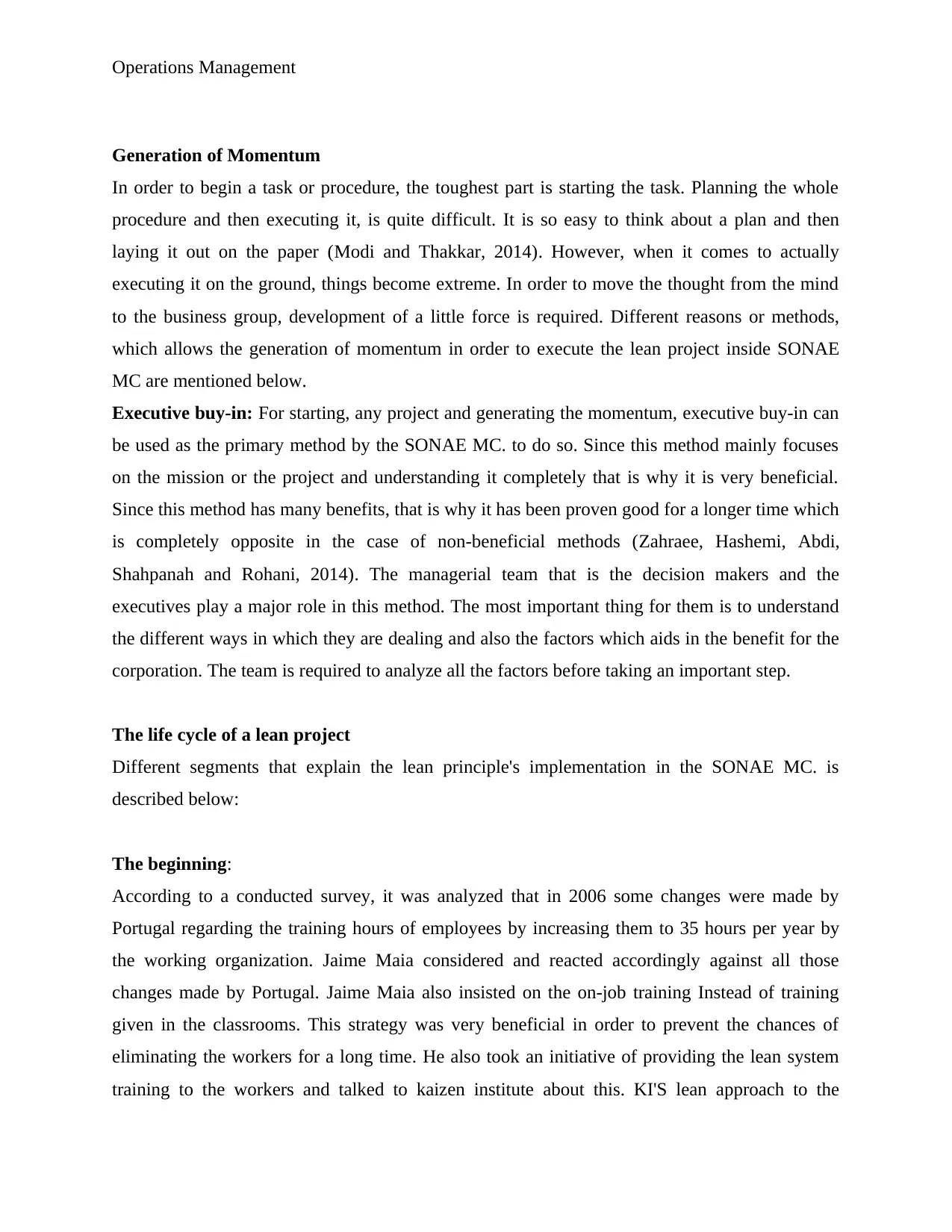
Operations Management
Generation of Momentum
In order to begin a task or procedure, the toughest part is starting the task. Planning the whole
procedure and then executing it, is quite difficult. It is so easy to think about a plan and then
laying it out on the paper (Modi and Thakkar, 2014). However, when it comes to actually
executing it on the ground, things become extreme. In order to move the thought from the mind
to the business group, development of a little force is required. Different reasons or methods,
which allows the generation of momentum in order to execute the lean project inside SONAE
MC are mentioned below.
Executive buy-in: For starting, any project and generating the momentum, executive buy-in can
be used as the primary method by the SONAE MC. to do so. Since this method mainly focuses
on the mission or the project and understanding it completely that is why it is very beneficial.
Since this method has many benefits, that is why it has been proven good for a longer time which
is completely opposite in the case of non-beneficial methods (Zahraee, Hashemi, Abdi,
Shahpanah and Rohani, 2014). The managerial team that is the decision makers and the
executives play a major role in this method. The most important thing for them is to understand
the different ways in which they are dealing and also the factors which aids in the benefit for the
corporation. The team is required to analyze all the factors before taking an important step.
The life cycle of a lean project
Different segments that explain the lean principle's implementation in the SONAE MC. is
described below:
The beginning:
According to a conducted survey, it was analyzed that in 2006 some changes were made by
Portugal regarding the training hours of employees by increasing them to 35 hours per year by
the working organization. Jaime Maia considered and reacted accordingly against all those
changes made by Portugal. Jaime Maia also insisted on the on-job training Instead of training
given in the classrooms. This strategy was very beneficial in order to prevent the chances of
eliminating the workers for a long time. He also took an initiative of providing the lean system
training to the workers and talked to kaizen institute about this. KI'S lean approach to the
Generation of Momentum
In order to begin a task or procedure, the toughest part is starting the task. Planning the whole
procedure and then executing it, is quite difficult. It is so easy to think about a plan and then
laying it out on the paper (Modi and Thakkar, 2014). However, when it comes to actually
executing it on the ground, things become extreme. In order to move the thought from the mind
to the business group, development of a little force is required. Different reasons or methods,
which allows the generation of momentum in order to execute the lean project inside SONAE
MC are mentioned below.
Executive buy-in: For starting, any project and generating the momentum, executive buy-in can
be used as the primary method by the SONAE MC. to do so. Since this method mainly focuses
on the mission or the project and understanding it completely that is why it is very beneficial.
Since this method has many benefits, that is why it has been proven good for a longer time which
is completely opposite in the case of non-beneficial methods (Zahraee, Hashemi, Abdi,
Shahpanah and Rohani, 2014). The managerial team that is the decision makers and the
executives play a major role in this method. The most important thing for them is to understand
the different ways in which they are dealing and also the factors which aids in the benefit for the
corporation. The team is required to analyze all the factors before taking an important step.
The life cycle of a lean project
Different segments that explain the lean principle's implementation in the SONAE MC. is
described below:
The beginning:
According to a conducted survey, it was analyzed that in 2006 some changes were made by
Portugal regarding the training hours of employees by increasing them to 35 hours per year by
the working organization. Jaime Maia considered and reacted accordingly against all those
changes made by Portugal. Jaime Maia also insisted on the on-job training Instead of training
given in the classrooms. This strategy was very beneficial in order to prevent the chances of
eliminating the workers for a long time. He also took an initiative of providing the lean system
training to the workers and talked to kaizen institute about this. KI'S lean approach to the
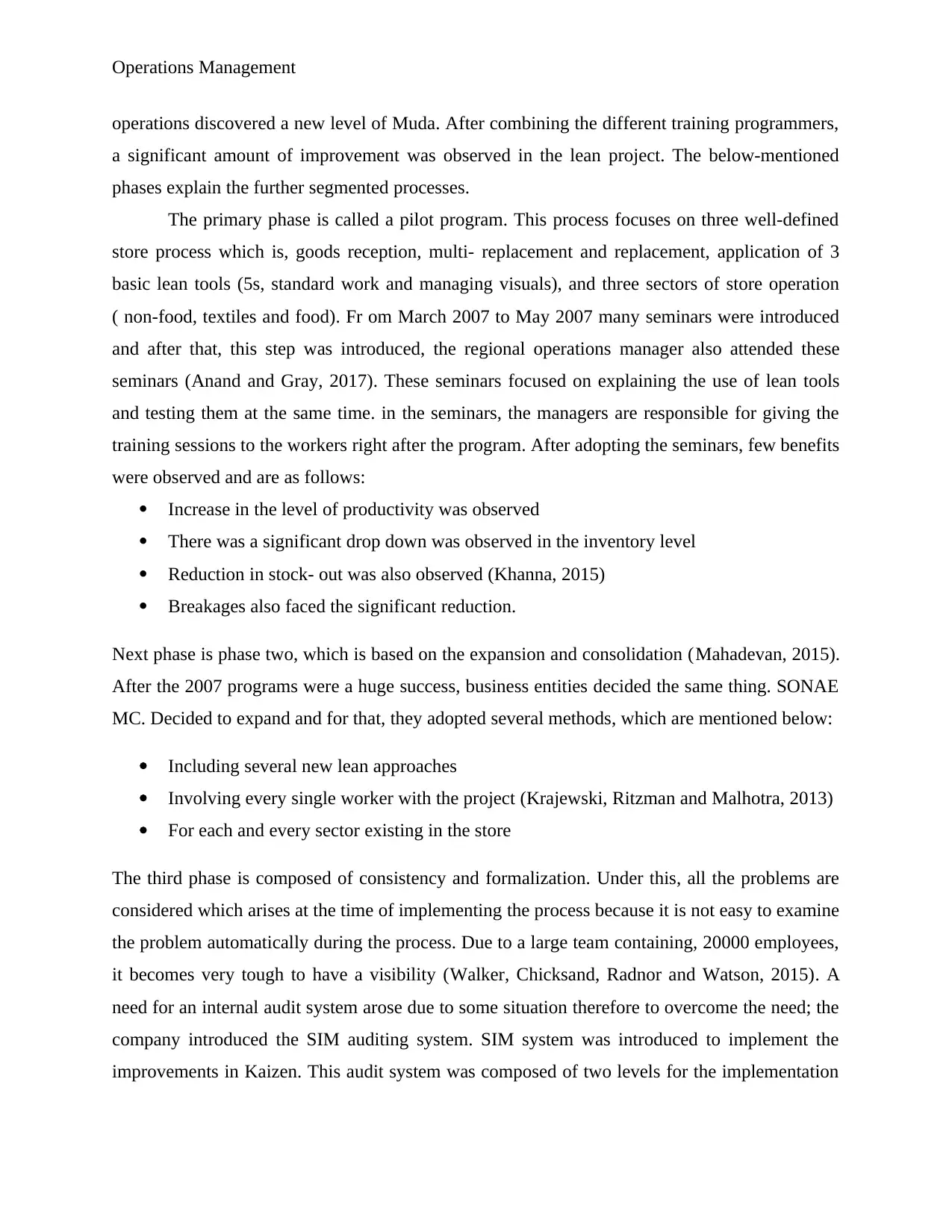
Operations Management
operations discovered a new level of Muda. After combining the different training programmers,
a significant amount of improvement was observed in the lean project. The below-mentioned
phases explain the further segmented processes.
The primary phase is called a pilot program. This process focuses on three well-defined
store process which is, goods reception, multi- replacement and replacement, application of 3
basic lean tools (5s, standard work and managing visuals), and three sectors of store operation
( non-food, textiles and food). Fr om March 2007 to May 2007 many seminars were introduced
and after that, this step was introduced, the regional operations manager also attended these
seminars (Anand and Gray, 2017). These seminars focused on explaining the use of lean tools
and testing them at the same time. in the seminars, the managers are responsible for giving the
training sessions to the workers right after the program. After adopting the seminars, few benefits
were observed and are as follows:
Increase in the level of productivity was observed
There was a significant drop down was observed in the inventory level
Reduction in stock- out was also observed (Khanna, 2015)
Breakages also faced the significant reduction.
Next phase is phase two, which is based on the expansion and consolidation (Mahadevan, 2015).
After the 2007 programs were a huge success, business entities decided the same thing. SONAE
MC. Decided to expand and for that, they adopted several methods, which are mentioned below:
Including several new lean approaches
Involving every single worker with the project (Krajewski, Ritzman and Malhotra, 2013)
For each and every sector existing in the store
The third phase is composed of consistency and formalization. Under this, all the problems are
considered which arises at the time of implementing the process because it is not easy to examine
the problem automatically during the process. Due to a large team containing, 20000 employees,
it becomes very tough to have a visibility (Walker, Chicksand, Radnor and Watson, 2015). A
need for an internal audit system arose due to some situation therefore to overcome the need; the
company introduced the SIM auditing system. SIM system was introduced to implement the
improvements in Kaizen. This audit system was composed of two levels for the implementation
operations discovered a new level of Muda. After combining the different training programmers,
a significant amount of improvement was observed in the lean project. The below-mentioned
phases explain the further segmented processes.
The primary phase is called a pilot program. This process focuses on three well-defined
store process which is, goods reception, multi- replacement and replacement, application of 3
basic lean tools (5s, standard work and managing visuals), and three sectors of store operation
( non-food, textiles and food). Fr om March 2007 to May 2007 many seminars were introduced
and after that, this step was introduced, the regional operations manager also attended these
seminars (Anand and Gray, 2017). These seminars focused on explaining the use of lean tools
and testing them at the same time. in the seminars, the managers are responsible for giving the
training sessions to the workers right after the program. After adopting the seminars, few benefits
were observed and are as follows:
Increase in the level of productivity was observed
There was a significant drop down was observed in the inventory level
Reduction in stock- out was also observed (Khanna, 2015)
Breakages also faced the significant reduction.
Next phase is phase two, which is based on the expansion and consolidation (Mahadevan, 2015).
After the 2007 programs were a huge success, business entities decided the same thing. SONAE
MC. Decided to expand and for that, they adopted several methods, which are mentioned below:
Including several new lean approaches
Involving every single worker with the project (Krajewski, Ritzman and Malhotra, 2013)
For each and every sector existing in the store
The third phase is composed of consistency and formalization. Under this, all the problems are
considered which arises at the time of implementing the process because it is not easy to examine
the problem automatically during the process. Due to a large team containing, 20000 employees,
it becomes very tough to have a visibility (Walker, Chicksand, Radnor and Watson, 2015). A
need for an internal audit system arose due to some situation therefore to overcome the need; the
company introduced the SIM auditing system. SIM system was introduced to implement the
improvements in Kaizen. This audit system was composed of two levels for the implementation
⊘ This is a preview!⊘
Do you want full access?
Subscribe today to unlock all pages.

Trusted by 1+ million students worldwide
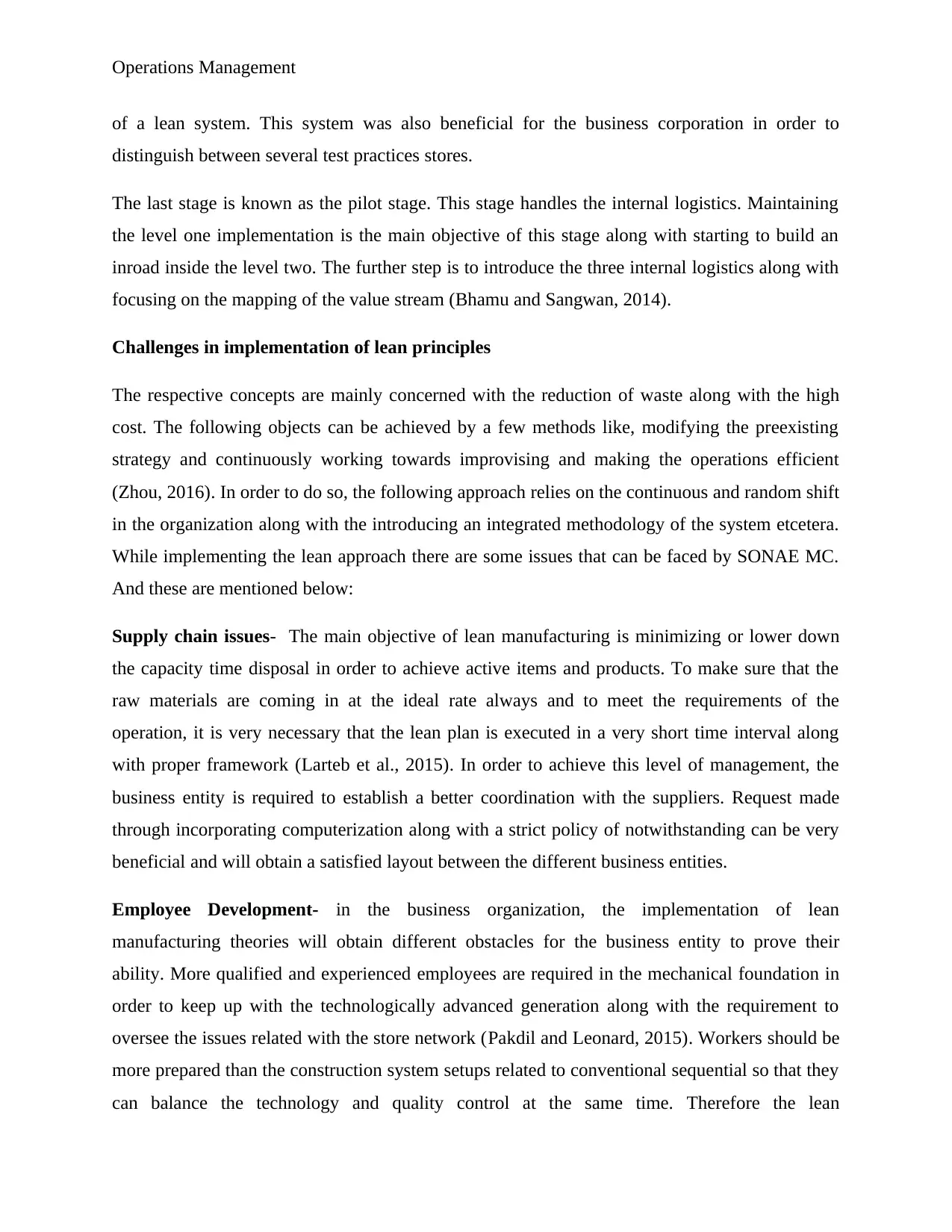
Operations Management
of a lean system. This system was also beneficial for the business corporation in order to
distinguish between several test practices stores.
The last stage is known as the pilot stage. This stage handles the internal logistics. Maintaining
the level one implementation is the main objective of this stage along with starting to build an
inroad inside the level two. The further step is to introduce the three internal logistics along with
focusing on the mapping of the value stream (Bhamu and Sangwan, 2014).
Challenges in implementation of lean principles
The respective concepts are mainly concerned with the reduction of waste along with the high
cost. The following objects can be achieved by a few methods like, modifying the preexisting
strategy and continuously working towards improvising and making the operations efficient
(Zhou, 2016). In order to do so, the following approach relies on the continuous and random shift
in the organization along with the introducing an integrated methodology of the system etcetera.
While implementing the lean approach there are some issues that can be faced by SONAE MC.
And these are mentioned below:
Supply chain issues- The main objective of lean manufacturing is minimizing or lower down
the capacity time disposal in order to achieve active items and products. To make sure that the
raw materials are coming in at the ideal rate always and to meet the requirements of the
operation, it is very necessary that the lean plan is executed in a very short time interval along
with proper framework (Larteb et al., 2015). In order to achieve this level of management, the
business entity is required to establish a better coordination with the suppliers. Request made
through incorporating computerization along with a strict policy of notwithstanding can be very
beneficial and will obtain a satisfied layout between the different business entities.
Employee Development- in the business organization, the implementation of lean
manufacturing theories will obtain different obstacles for the business entity to prove their
ability. More qualified and experienced employees are required in the mechanical foundation in
order to keep up with the technologically advanced generation along with the requirement to
oversee the issues related with the store network (Pakdil and Leonard, 2015). Workers should be
more prepared than the construction system setups related to conventional sequential so that they
can balance the technology and quality control at the same time. Therefore the lean
of a lean system. This system was also beneficial for the business corporation in order to
distinguish between several test practices stores.
The last stage is known as the pilot stage. This stage handles the internal logistics. Maintaining
the level one implementation is the main objective of this stage along with starting to build an
inroad inside the level two. The further step is to introduce the three internal logistics along with
focusing on the mapping of the value stream (Bhamu and Sangwan, 2014).
Challenges in implementation of lean principles
The respective concepts are mainly concerned with the reduction of waste along with the high
cost. The following objects can be achieved by a few methods like, modifying the preexisting
strategy and continuously working towards improvising and making the operations efficient
(Zhou, 2016). In order to do so, the following approach relies on the continuous and random shift
in the organization along with the introducing an integrated methodology of the system etcetera.
While implementing the lean approach there are some issues that can be faced by SONAE MC.
And these are mentioned below:
Supply chain issues- The main objective of lean manufacturing is minimizing or lower down
the capacity time disposal in order to achieve active items and products. To make sure that the
raw materials are coming in at the ideal rate always and to meet the requirements of the
operation, it is very necessary that the lean plan is executed in a very short time interval along
with proper framework (Larteb et al., 2015). In order to achieve this level of management, the
business entity is required to establish a better coordination with the suppliers. Request made
through incorporating computerization along with a strict policy of notwithstanding can be very
beneficial and will obtain a satisfied layout between the different business entities.
Employee Development- in the business organization, the implementation of lean
manufacturing theories will obtain different obstacles for the business entity to prove their
ability. More qualified and experienced employees are required in the mechanical foundation in
order to keep up with the technologically advanced generation along with the requirement to
oversee the issues related with the store network (Pakdil and Leonard, 2015). Workers should be
more prepared than the construction system setups related to conventional sequential so that they
can balance the technology and quality control at the same time. Therefore the lean
Paraphrase This Document
Need a fresh take? Get an instant paraphrase of this document with our AI Paraphraser
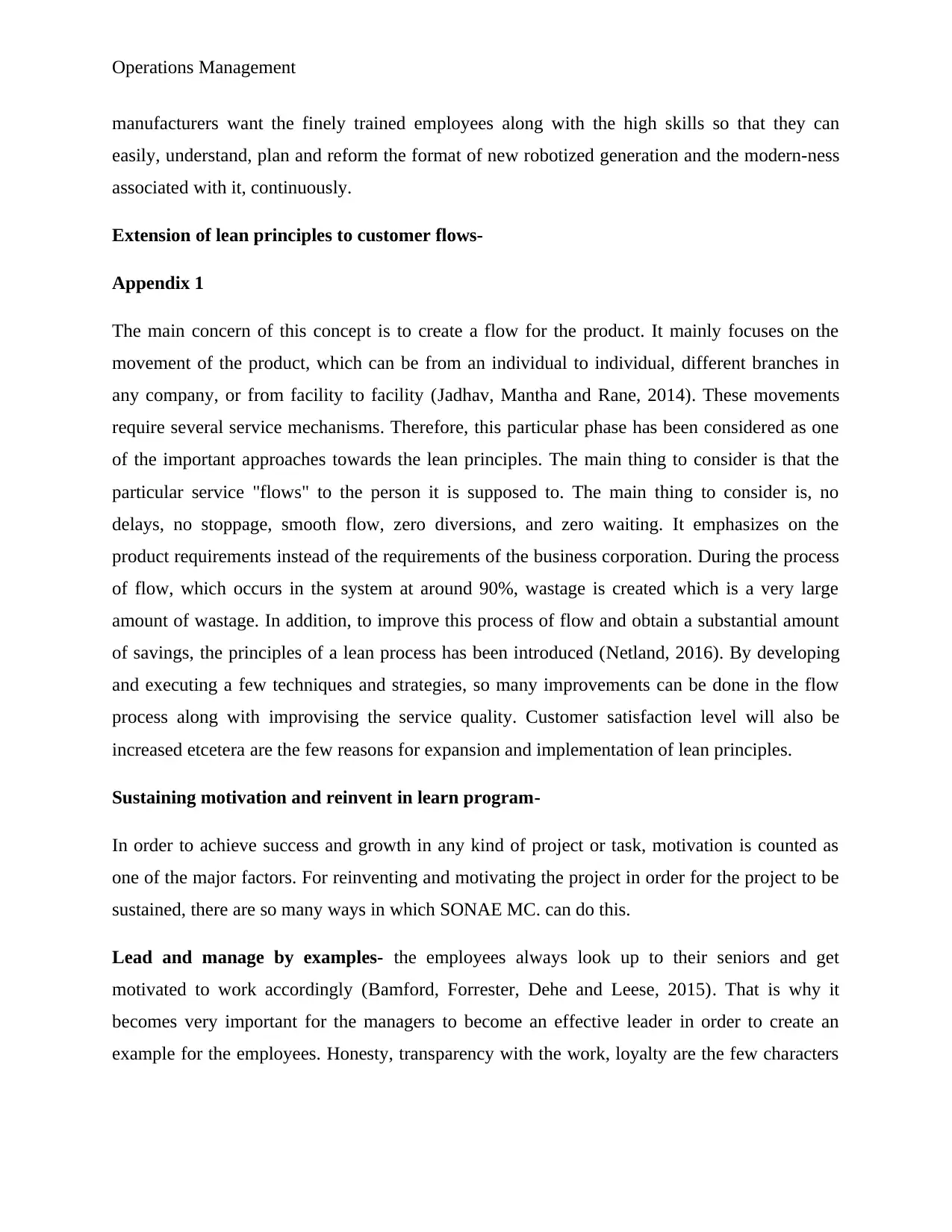
Operations Management
manufacturers want the finely trained employees along with the high skills so that they can
easily, understand, plan and reform the format of new robotized generation and the modern-ness
associated with it, continuously.
Extension of lean principles to customer flows-
Appendix 1
The main concern of this concept is to create a flow for the product. It mainly focuses on the
movement of the product, which can be from an individual to individual, different branches in
any company, or from facility to facility (Jadhav, Mantha and Rane, 2014). These movements
require several service mechanisms. Therefore, this particular phase has been considered as one
of the important approaches towards the lean principles. The main thing to consider is that the
particular service "flows" to the person it is supposed to. The main thing to consider is, no
delays, no stoppage, smooth flow, zero diversions, and zero waiting. It emphasizes on the
product requirements instead of the requirements of the business corporation. During the process
of flow, which occurs in the system at around 90%, wastage is created which is a very large
amount of wastage. In addition, to improve this process of flow and obtain a substantial amount
of savings, the principles of a lean process has been introduced (Netland, 2016). By developing
and executing a few techniques and strategies, so many improvements can be done in the flow
process along with improvising the service quality. Customer satisfaction level will also be
increased etcetera are the few reasons for expansion and implementation of lean principles.
Sustaining motivation and reinvent in learn program-
In order to achieve success and growth in any kind of project or task, motivation is counted as
one of the major factors. For reinventing and motivating the project in order for the project to be
sustained, there are so many ways in which SONAE MC. can do this.
Lead and manage by examples- the employees always look up to their seniors and get
motivated to work accordingly (Bamford, Forrester, Dehe and Leese, 2015). That is why it
becomes very important for the managers to become an effective leader in order to create an
example for the employees. Honesty, transparency with the work, loyalty are the few characters
manufacturers want the finely trained employees along with the high skills so that they can
easily, understand, plan and reform the format of new robotized generation and the modern-ness
associated with it, continuously.
Extension of lean principles to customer flows-
Appendix 1
The main concern of this concept is to create a flow for the product. It mainly focuses on the
movement of the product, which can be from an individual to individual, different branches in
any company, or from facility to facility (Jadhav, Mantha and Rane, 2014). These movements
require several service mechanisms. Therefore, this particular phase has been considered as one
of the important approaches towards the lean principles. The main thing to consider is that the
particular service "flows" to the person it is supposed to. The main thing to consider is, no
delays, no stoppage, smooth flow, zero diversions, and zero waiting. It emphasizes on the
product requirements instead of the requirements of the business corporation. During the process
of flow, which occurs in the system at around 90%, wastage is created which is a very large
amount of wastage. In addition, to improve this process of flow and obtain a substantial amount
of savings, the principles of a lean process has been introduced (Netland, 2016). By developing
and executing a few techniques and strategies, so many improvements can be done in the flow
process along with improvising the service quality. Customer satisfaction level will also be
increased etcetera are the few reasons for expansion and implementation of lean principles.
Sustaining motivation and reinvent in learn program-
In order to achieve success and growth in any kind of project or task, motivation is counted as
one of the major factors. For reinventing and motivating the project in order for the project to be
sustained, there are so many ways in which SONAE MC. can do this.
Lead and manage by examples- the employees always look up to their seniors and get
motivated to work accordingly (Bamford, Forrester, Dehe and Leese, 2015). That is why it
becomes very important for the managers to become an effective leader in order to create an
example for the employees. Honesty, transparency with the work, loyalty are the few characters
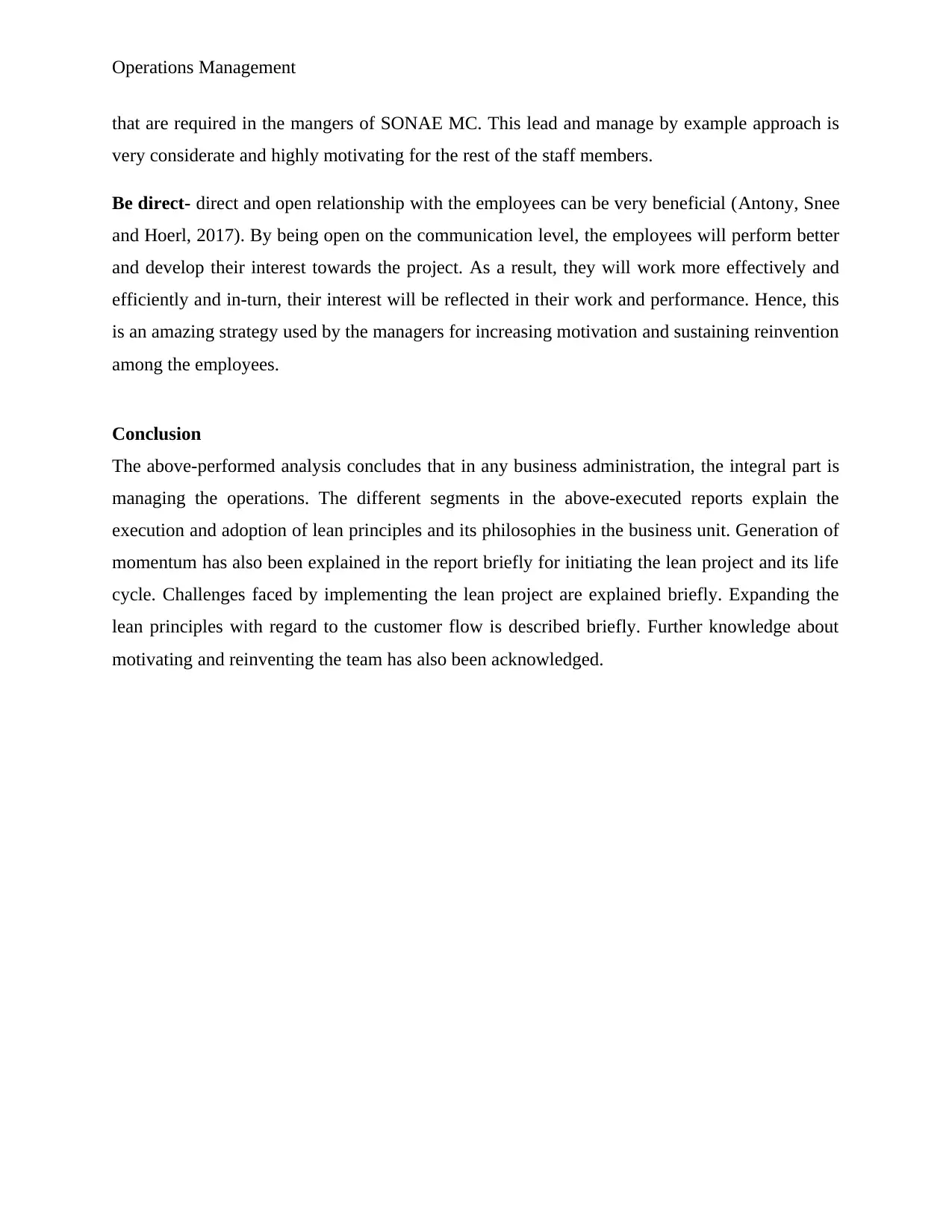
Operations Management
that are required in the mangers of SONAE MC. This lead and manage by example approach is
very considerate and highly motivating for the rest of the staff members.
Be direct- direct and open relationship with the employees can be very beneficial (Antony, Snee
and Hoerl, 2017). By being open on the communication level, the employees will perform better
and develop their interest towards the project. As a result, they will work more effectively and
efficiently and in-turn, their interest will be reflected in their work and performance. Hence, this
is an amazing strategy used by the managers for increasing motivation and sustaining reinvention
among the employees.
Conclusion
The above-performed analysis concludes that in any business administration, the integral part is
managing the operations. The different segments in the above-executed reports explain the
execution and adoption of lean principles and its philosophies in the business unit. Generation of
momentum has also been explained in the report briefly for initiating the lean project and its life
cycle. Challenges faced by implementing the lean project are explained briefly. Expanding the
lean principles with regard to the customer flow is described briefly. Further knowledge about
motivating and reinventing the team has also been acknowledged.
that are required in the mangers of SONAE MC. This lead and manage by example approach is
very considerate and highly motivating for the rest of the staff members.
Be direct- direct and open relationship with the employees can be very beneficial (Antony, Snee
and Hoerl, 2017). By being open on the communication level, the employees will perform better
and develop their interest towards the project. As a result, they will work more effectively and
efficiently and in-turn, their interest will be reflected in their work and performance. Hence, this
is an amazing strategy used by the managers for increasing motivation and sustaining reinvention
among the employees.
Conclusion
The above-performed analysis concludes that in any business administration, the integral part is
managing the operations. The different segments in the above-executed reports explain the
execution and adoption of lean principles and its philosophies in the business unit. Generation of
momentum has also been explained in the report briefly for initiating the lean project and its life
cycle. Challenges faced by implementing the lean project are explained briefly. Expanding the
lean principles with regard to the customer flow is described briefly. Further knowledge about
motivating and reinventing the team has also been acknowledged.
⊘ This is a preview!⊘
Do you want full access?
Subscribe today to unlock all pages.

Trusted by 1+ million students worldwide
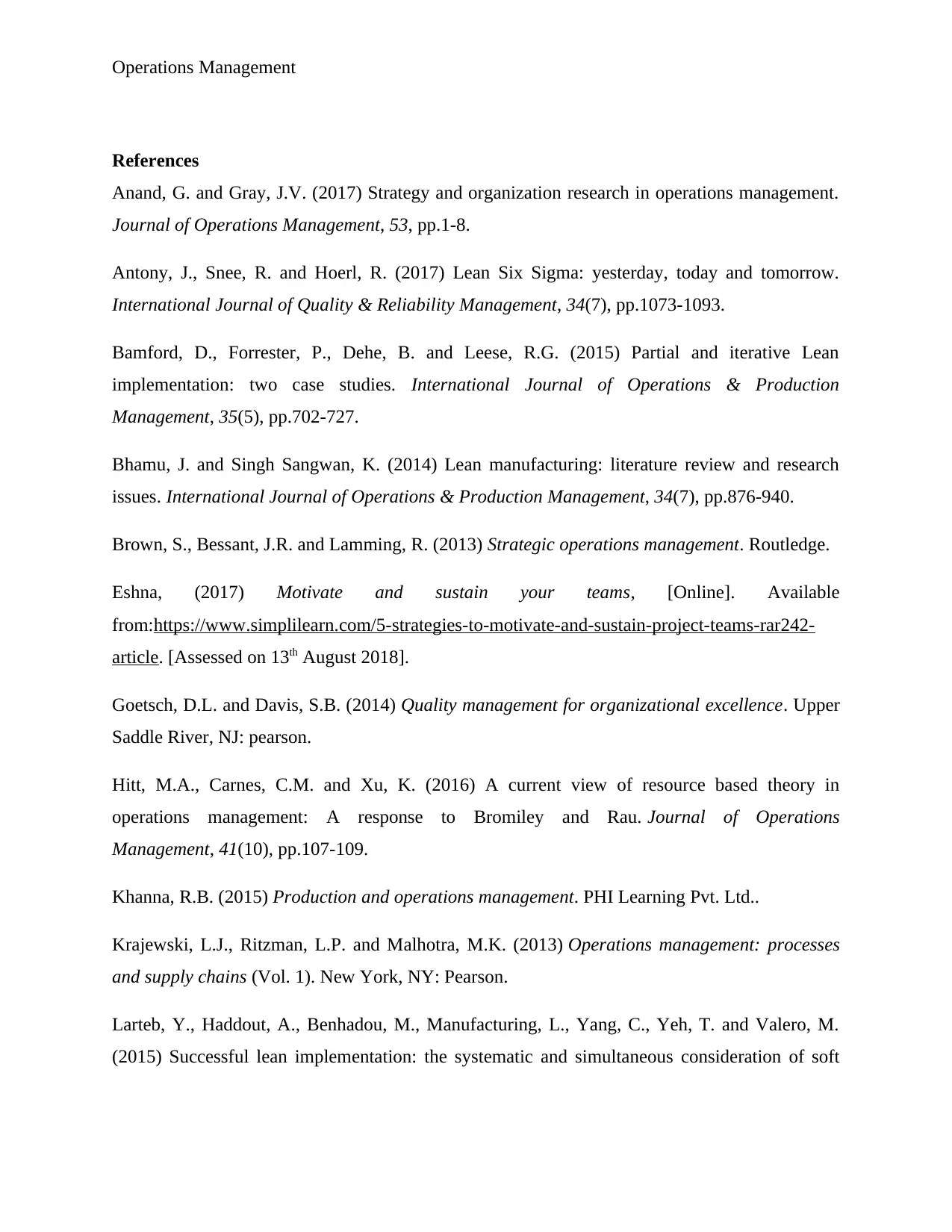
Operations Management
References
Anand, G. and Gray, J.V. (2017) Strategy and organization research in operations management.
Journal of Operations Management, 53, pp.1-8.
Antony, J., Snee, R. and Hoerl, R. (2017) Lean Six Sigma: yesterday, today and tomorrow.
International Journal of Quality & Reliability Management, 34(7), pp.1073-1093.
Bamford, D., Forrester, P., Dehe, B. and Leese, R.G. (2015) Partial and iterative Lean
implementation: two case studies. International Journal of Operations & Production
Management, 35(5), pp.702-727.
Bhamu, J. and Singh Sangwan, K. (2014) Lean manufacturing: literature review and research
issues. International Journal of Operations & Production Management, 34(7), pp.876-940.
Brown, S., Bessant, J.R. and Lamming, R. (2013) Strategic operations management. Routledge.
Eshna, (2017) Motivate and sustain your teams, [Online]. Available
from:https://www.simplilearn.com/5-strategies-to-motivate-and-sustain-project-teams-rar242-
article. [Assessed on 13th August 2018].
Goetsch, D.L. and Davis, S.B. (2014) Quality management for organizational excellence. Upper
Saddle River, NJ: pearson.
Hitt, M.A., Carnes, C.M. and Xu, K. (2016) A current view of resource based theory in
operations management: A response to Bromiley and Rau. Journal of Operations
Management, 41(10), pp.107-109.
Khanna, R.B. (2015) Production and operations management. PHI Learning Pvt. Ltd..
Krajewski, L.J., Ritzman, L.P. and Malhotra, M.K. (2013) Operations management: processes
and supply chains (Vol. 1). New York, NY: Pearson.
Larteb, Y., Haddout, A., Benhadou, M., Manufacturing, L., Yang, C., Yeh, T. and Valero, M.
(2015) Successful lean implementation: the systematic and simultaneous consideration of soft
References
Anand, G. and Gray, J.V. (2017) Strategy and organization research in operations management.
Journal of Operations Management, 53, pp.1-8.
Antony, J., Snee, R. and Hoerl, R. (2017) Lean Six Sigma: yesterday, today and tomorrow.
International Journal of Quality & Reliability Management, 34(7), pp.1073-1093.
Bamford, D., Forrester, P., Dehe, B. and Leese, R.G. (2015) Partial and iterative Lean
implementation: two case studies. International Journal of Operations & Production
Management, 35(5), pp.702-727.
Bhamu, J. and Singh Sangwan, K. (2014) Lean manufacturing: literature review and research
issues. International Journal of Operations & Production Management, 34(7), pp.876-940.
Brown, S., Bessant, J.R. and Lamming, R. (2013) Strategic operations management. Routledge.
Eshna, (2017) Motivate and sustain your teams, [Online]. Available
from:https://www.simplilearn.com/5-strategies-to-motivate-and-sustain-project-teams-rar242-
article. [Assessed on 13th August 2018].
Goetsch, D.L. and Davis, S.B. (2014) Quality management for organizational excellence. Upper
Saddle River, NJ: pearson.
Hitt, M.A., Carnes, C.M. and Xu, K. (2016) A current view of resource based theory in
operations management: A response to Bromiley and Rau. Journal of Operations
Management, 41(10), pp.107-109.
Khanna, R.B. (2015) Production and operations management. PHI Learning Pvt. Ltd..
Krajewski, L.J., Ritzman, L.P. and Malhotra, M.K. (2013) Operations management: processes
and supply chains (Vol. 1). New York, NY: Pearson.
Larteb, Y., Haddout, A., Benhadou, M., Manufacturing, L., Yang, C., Yeh, T. and Valero, M.
(2015) Successful lean implementation: the systematic and simultaneous consideration of soft
Paraphrase This Document
Need a fresh take? Get an instant paraphrase of this document with our AI Paraphraser
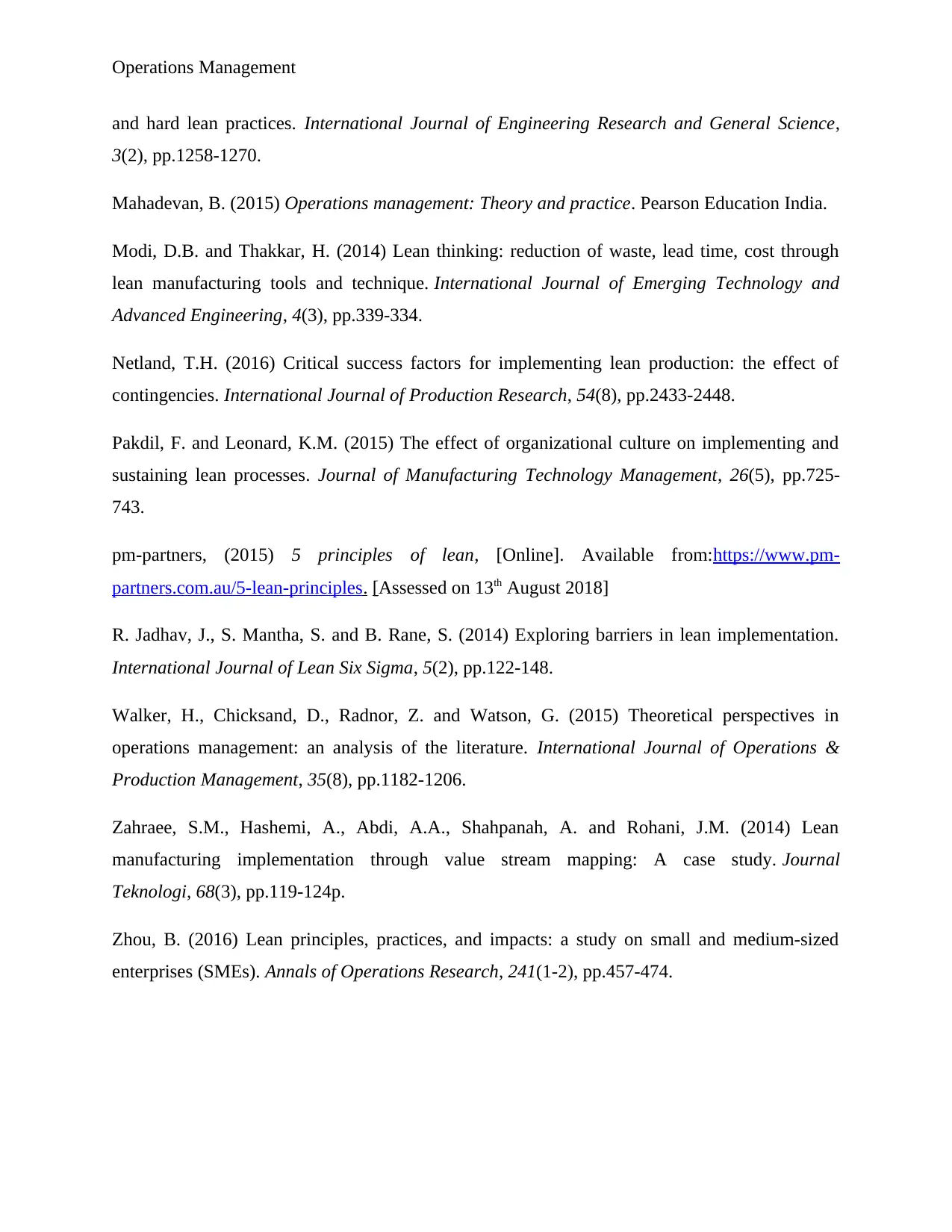
Operations Management
and hard lean practices. International Journal of Engineering Research and General Science,
3(2), pp.1258-1270.
Mahadevan, B. (2015) Operations management: Theory and practice. Pearson Education India.
Modi, D.B. and Thakkar, H. (2014) Lean thinking: reduction of waste, lead time, cost through
lean manufacturing tools and technique. International Journal of Emerging Technology and
Advanced Engineering, 4(3), pp.339-334.
Netland, T.H. (2016) Critical success factors for implementing lean production: the effect of
contingencies. International Journal of Production Research, 54(8), pp.2433-2448.
Pakdil, F. and Leonard, K.M. (2015) The effect of organizational culture on implementing and
sustaining lean processes. Journal of Manufacturing Technology Management, 26(5), pp.725-
743.
pm-partners, (2015) 5 principles of lean, [Online]. Available from:https://www.pm-
partners.com.au/5-lean-principles. [Assessed on 13th August 2018]
R. Jadhav, J., S. Mantha, S. and B. Rane, S. (2014) Exploring barriers in lean implementation.
International Journal of Lean Six Sigma, 5(2), pp.122-148.
Walker, H., Chicksand, D., Radnor, Z. and Watson, G. (2015) Theoretical perspectives in
operations management: an analysis of the literature. International Journal of Operations &
Production Management, 35(8), pp.1182-1206.
Zahraee, S.M., Hashemi, A., Abdi, A.A., Shahpanah, A. and Rohani, J.M. (2014) Lean
manufacturing implementation through value stream mapping: A case study. Journal
Teknologi, 68(3), pp.119-124p.
Zhou, B. (2016) Lean principles, practices, and impacts: a study on small and medium-sized
enterprises (SMEs). Annals of Operations Research, 241(1-2), pp.457-474.
and hard lean practices. International Journal of Engineering Research and General Science,
3(2), pp.1258-1270.
Mahadevan, B. (2015) Operations management: Theory and practice. Pearson Education India.
Modi, D.B. and Thakkar, H. (2014) Lean thinking: reduction of waste, lead time, cost through
lean manufacturing tools and technique. International Journal of Emerging Technology and
Advanced Engineering, 4(3), pp.339-334.
Netland, T.H. (2016) Critical success factors for implementing lean production: the effect of
contingencies. International Journal of Production Research, 54(8), pp.2433-2448.
Pakdil, F. and Leonard, K.M. (2015) The effect of organizational culture on implementing and
sustaining lean processes. Journal of Manufacturing Technology Management, 26(5), pp.725-
743.
pm-partners, (2015) 5 principles of lean, [Online]. Available from:https://www.pm-
partners.com.au/5-lean-principles. [Assessed on 13th August 2018]
R. Jadhav, J., S. Mantha, S. and B. Rane, S. (2014) Exploring barriers in lean implementation.
International Journal of Lean Six Sigma, 5(2), pp.122-148.
Walker, H., Chicksand, D., Radnor, Z. and Watson, G. (2015) Theoretical perspectives in
operations management: an analysis of the literature. International Journal of Operations &
Production Management, 35(8), pp.1182-1206.
Zahraee, S.M., Hashemi, A., Abdi, A.A., Shahpanah, A. and Rohani, J.M. (2014) Lean
manufacturing implementation through value stream mapping: A case study. Journal
Teknologi, 68(3), pp.119-124p.
Zhou, B. (2016) Lean principles, practices, and impacts: a study on small and medium-sized
enterprises (SMEs). Annals of Operations Research, 241(1-2), pp.457-474.
1 out of 11
Related Documents
Your All-in-One AI-Powered Toolkit for Academic Success.
+13062052269
info@desklib.com
Available 24*7 on WhatsApp / Email
![[object Object]](/_next/static/media/star-bottom.7253800d.svg)
Unlock your academic potential
Copyright © 2020–2025 A2Z Services. All Rights Reserved. Developed and managed by ZUCOL.



